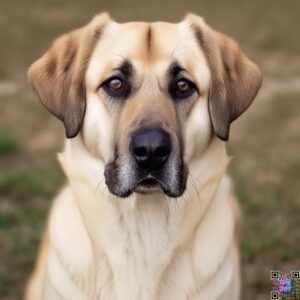Introduction
The Anatolian Shepherd and Lab mix, often referred to as the “Anatolab,” is a captivating hybrid breed that combines the rugged resilience of the Anatolian Shepherd with the friendly, family-oriented nature of the Labrador Retriever. This unique canine combination has captured the hearts of many pet owners, offering a unique blend of traits that make them both versatile and endearing companions.
Exploring the Origins and Characteristics of the Anatolian Shepherd

The Anatolian Shepherd is an ancient breed that originated in the Anatolian region of Turkey, where it was historically used as a livestock guardian dog. These majestic canines are known for their impressive size, muscular build, and unwavering loyalty. With their thick, double-layered coats and distinctive facial features, Anatolian Shepherds are instantly recognizable.
Introducing the Labrador Retriever: A Beloved Companion Breed
On the other hand, the Labrador Retriever is one of the most popular and beloved companion breeds in the world. Originating in Newfoundland, Canada, Labradors are renowned for their friendly, outgoing personalities, intelligence, and versatility. They excel as family pets, service dogs, and in various canine sports and activities.
The Anatolian Shepherd and Lab Mix
An Anatolian Shepherd and Labrador Retriever mix combines the traits of two strong and intelligent breeds. Here’s an overview of both parent breeds and what you can expect from the mix:
Anatolian Shepherd
- Origin: Turkey, where they were used to guard livestock from predators.
- Size: Large (90–150 pounds, 27–30 inches tall).
- Temperament: Independent, intelligent, and protective. They are known for being excellent guard dogs but can also be affectionate and loyal with their family.
- Coat: Thick, double-layered coat that can be short or medium-length, often in fawn, white, or brindle.
- Exercise Needs: Moderate to high; they need regular mental and physical stimulation, particularly since they were bred for guarding.
Labrador Retriever
- Origin: Canada, originally bred for retrieving in water.
- Size: Medium to large (55–80 pounds, 21.5–24.5 inches tall).
- Temperament: Friendly, sociable, and good-natured. Labs are known for being great family dogs and easy to train.
- Coat: Short, dense, and water-resistant. Typically in yellow, chocolate, or black.
- Exercise Needs: High; they are active, enjoy playing, swimming, and running.
Anatolian Shepherd and Labrador Mix
- Size: Typically medium to large, though it will depend on the traits inherited from each parent. Expect a dog that can range from 60 to 120 pounds.
- Temperament: Likely to be loyal, protective, and intelligent like the Anatolian Shepherd, but with the friendly, outgoing nature of the Labrador. The mix might be good for families, but also requires proper training and socialization. They could also have a strong guarding instinct.
- Appearance: This mix can have a variety of coat colors, often with a medium to long-length coat that could be thick. They may have the Labrador’s friendly expression combined with the Anatolian Shepherd’s strong, robust build.
- Exercise Needs: High, as both breeds are active. The mix will need plenty of daily exercise and mental stimulation to stay happy.
- Training: They may be independent like the Anatolian Shepherd but can be trained with consistency and positive reinforcement, especially if they inherit the Labrador’s eagerness to please.
The Anatolian Shepherd and Lab mix is a crossbreed that combines the protective nature of the Anatolian Shepherd with the friendly disposition of the Labrador Retriever. This mix often results in a dog that is not only loyal but also sociable and adaptable. Understanding both parent breeds can provide insights into what you can expect from this unique hybrid.
Understanding the Labrador Retriever
Labrador Retrievers are one of the most popular dog breeds worldwide. Known for their friendly demeanor and intelligence, Labs are often used as service dogs due to their trainability. They typically weigh between 55 to 80 pounds and stand about 21.5 to 24.5 inches tall. Their short coat comes in three primary colors: black, yellow, and chocolate. Labs are known for their playful nature and love for water activities, making them great companions for active families.
Defining the Anatolian Shepherd and Lab Mix
The Anatolian Shepherd and Lab mix is a designer breed that combines the best traits of these two remarkable canine breeds. By crossing an Anatolian Shepherd with a Labrador Retriever, breeders have created a unique hybrid that often exhibits a blend of physical and behavioral characteristics from both parent breeds.
Physical Traits of the Anatolian Shepherd and Lab Mix
Anatolian Shepherd and Lab mixes can vary in their physical appearance, as the traits they inherit from each parent breed can differ. However, they often display a muscular, well-proportioned build, with a medium to large size. Their coats may range from short and smooth like the Labrador’s to longer and thicker like the Anatolian Shepherd’s, and can come in a variety of colors, including black, brown, tan, and white.
Temperament and Personality of the Anatolian Shepherd and Lab Mix
The Anatolian Shepherd and Lab mix is known for its friendly, loyal, and affectionate nature. They often inherit the Labrador’s outgoing personality and the Anatolian Shepherd’s protective instincts, making them excellent family companions. These dogs are typically intelligent, eager to please, and responsive to training, though they may also exhibit some independent tendencies from their Anatolian Shepherd heritage.
Factors Influencing the Average Weight
The average weight of an Anatolian Shepherd and Lab mix can vary significantly, as it is influenced by several factors, including the size and weight of the parent breeds, the individual dog’s genetics, and their overall health and nutrition.
Typical Weight Range for the Anatolian Shepherd and Lab Mix
Generally, Anatolian Shepherd and Lab mixes can range in weight from around 60 to 120 pounds, with males typically being larger than females. However, it’s important to note that individual dogs may fall outside of this range, as their weight can be influenced by a variety of factors.
Considerations for Maintaining a Healthy Weight
Maintaining a healthy weight is crucial for the overall well-being of an Anatolian Shepherd and Lab mix. Factors such as proper nutrition, regular exercise, and monitoring by a veterinarian can all contribute to ensuring the dog maintains an optimal weight and avoids potential health issues associated with obesity or underweight conditions.
Nutritional Needs and Dietary Considerations
Anatolian Shepherd and Lab mixes have specific nutritional needs that should be addressed through a balanced, high-quality diet. Factors such as the dog’s age, activity level, and any underlying health conditions should be taken into account when determining the appropriate food and portion sizes.
Exercise Requirements and Activity Levels
As a large, energetic breed, the Anatolian Shepherd and Lab mix requires regular exercise to maintain their physical and mental well-being. These dogs thrive on activities such as long walks, hikes, swimming, and playtime in a secure, fenced-in area.
Grooming and Coat Care
The Anatolian Shepherd and Lab mix’s coat can range from short and smooth to longer and thicker, depending on the individual dog’s genetics. Regular brushing, bathing, and grooming are essential to maintain the coat’s health and prevent matting or excessive shedding.
Importance of Early Socialization
Socializing an Anatolian Shepherd and Lab mix from a young age is crucial to help them develop into well-adjusted, confident, and friendly companions. Exposure to a variety of people, animals, and environments can help these dogs become more adaptable and less prone to behavioral issues.
Effective Training Techniques
Anatolian Shepherd and Lab mixes are generally intelligent and responsive to training, but they may also exhibit some independent tendencies. Positive reinforcement-based training methods, combined with patience and consistency, are often the most effective approach for these dogs.
Addressing Common Behavioral Challenges
While Anatolian Shepherd and Lab mixes are generally well-behaved, they may sometimes exhibit behaviors such as excessive barking, digging, or separation anxiety. Addressing these challenges through proper training, environmental enrichment, and management strategies can help ensure a harmonious relationship between the dog and their owners.
Common Health Issues and Preventive Measures
Like any breed, the Anatolian Shepherd and Lab mix may be predisposed to certain health conditions, such as hip and elbow dysplasia, thyroid disorders, and skin allergies. Regular veterinary check-ups, preventive care, and a healthy lifestyle can help mitigate these risks and ensure the dog’s long-term well-being.
Lifespan and Longevity Factors
The average lifespan of an Anatolian Shepherd and Lab mix can range from 10 to 15 years, depending on various factors, including genetics, diet, exercise, and overall health. Proper care and attention can help these dogs reach the upper end of this lifespan range.
Finding Reputable Breeders and Rescue Organizations
When considering the adoption of an Anatolian Shepherd and Lab mix, it’s essential to research and connect with reputable breeders or rescue organizations that prioritize the health, temperament, and well-being of these dogs. This can help ensure a successful and rewarding adoption experience.
Preparing Your Home and Family for the Adoption
Welcoming an Anatolian Shepherd and Lab mix into your home requires careful preparation. This includes ensuring your living space is suitable for a large, active breed, introducing the dog to your family members and any existing pets, and establishing a consistent routine and training plan.
Transitioning the Anatolian Shepherd and Lab Mix into Your Home
The transition period for an Anatolian Shepherd and Lab mix can be both exciting and challenging. Patience, positive reinforcement, and a gradual acclimation process can help the dog feel safe, secure, and comfortable in their new environment.
Bringing an Anatolian Shepherd and Labrador Retriever mix (often referred to as an Anatolian Lab mix) into your home can be a rewarding experience, as these dogs can be loving, protective, and intelligent. However, transitioning them into your home requires patience, consistency, and an understanding of their unique temperament. Here’s a guide to help you:
1. Prepare Your Home
- Space: Both the Anatolian Shepherd and Labrador Retriever are large breeds, so ensure you have ample space at home. They enjoy having room to move around, but Anatolian Shepherds are also known for being more independent and territorial, while Labs are social.
- Secure Your Yard: If you have a yard, it should be secure, as Anatolian Shepherds have guarding instincts and may try to protect your property. Make sure your fence is tall and secure enough to keep them in.
- Introduce a Comfortable Sleeping Area: Set up a designated sleeping area for your dog. They may appreciate a large, quiet space where they can retreat when they need rest.
2. Initial Introduction to the Home
- Slow Introduction: On the first day, keep interactions with new people or pets gradual. Introduce your new dog to one room at a time. Give them time to adjust to the new environment and avoid overwhelming them.
- Create a Safe Space: Provide a quiet place where they can retreat if they feel stressed or uncertain, especially the Anatolian Shepherd, who may be more independent and reserved compared to the Labrador mix.
3. Establish a Routine
- Feeding and Potty Schedules: Dogs thrive on routines, so establish a consistent feeding schedule and potty breaks. Make sure to take your dog out regularly, especially in the first few weeks while they’re adjusting.
- Exercise and Play: Both breeds have high energy levels, with the Lab being more playful and the Anatolian more protective. They will need daily exercise—consider long walks, playtime, or activities like fetch. Just make sure the exercise aligns with their energy needs.
4. Training and Socialization
- Basic Commands: Start with basic training early on. Both Anatolian Shepherds and Labs are intelligent, but they have different motivations. While Labs tend to be eager to please, Anatolian Shepherds may be more independent and protective. Consistent and positive reinforcement training will be important for both breeds.
- Socialization: Make sure to expose your new dog to different people, environments, and other animals (safely) to avoid territorial behaviors, especially from the Anatolian Shepherd side. Gradually socialize them to help them be well-adjusted.
- Leash Training: The Anatolian Shepherd can be strong-willed, so leash training is key, especially for walks in public areas. You’ll want to teach them to walk calmly by your side without pulling.
5. Patience and Bonding
- Allow Time to Adjust: It might take time for your dog to fully settle into the new environment, especially if they’re older or have had past experiences that make them more reserved. Give them time to adjust at their own pace.
- Bonding: Spend quality time with your dog, playing, training, and being affectionate. Positive interactions will help you build a strong bond and trust, especially with an Anatolian Shepherd, who may take longer to fully trust new people.
6. Monitoring Health
- Veterinary Care: Schedule a checkup with a veterinarian to ensure your dog is healthy and up to date on vaccinations. Ask the vet about any special care your specific mix may need.
- Diet: Feed them a balanced diet suitable for their size and activity level. Both breeds have potential for hip or joint issues, so consider a diet that supports joint health.
7. Dealing with Behavioral Traits
- Guarding Instincts: Anatolian Shepherds are natural protectors, and if they feel their territory is being threatened, they may show guarding behaviors. Watch for signs of aggression or over-protectiveness, especially in new situations or with strangers.
- Separation Anxiety: Both breeds can be prone to separation anxiety if left alone for long periods. Work on gradually getting them used to alone time by leaving them for short periods and gradually increasing the time.
- Mouthing and Chewing: Labrador Retrievers can be mouthy and tend to chew, especially as puppies. Providing chew toys and redirecting them from inappropriate chewing will be important.
8. Adjustment Period
- Time and Patience: Some dogs, particularly Anatolian Shepherd mixes, may take time to adjust, especially if they are more independent or less familiar with family dynamics. Be patient as they learn to trust you and understand the rules of your home.
- Respect Their Space: While Labs are typically more social, the Anatolian Shepherd side may need more personal space and time alone. Be mindful of this and avoid pushing them into interactions before they’re ready.
Frequently Asked Questions (FAQs)
1- What is the lifespan of an Anatolian Shepherd and Lab mix?
Typically between 10-14 years depending on genetics and care.
2- Are they good family dogs?
Yes! They tend to be loyal companions who bond well with families when properly trained.
3- How much exercise do they need?
At least one hour daily; activities like walks or playtime are essential.
4- Do they have any specific health issues?
They may inherit conditions common in either breed such as hip dysplasia or obesity-related issues.
5- How do I train my mixed breed effectively?
Use positive reinforcement techniques; consistency is key.
6- Can they live in apartments?
While possible if exercised adequately daily; homes with yards are generally better suited.

Conclusion: Embracing the Unique Charm of the Anatolian Shepherd and Lab Mix
The Anatolian Shepherd and Lab mix is a truly unique and captivating canine companion. By understanding their origins, physical traits, temperament, and care requirements, prospective owners can make an informed decision and provide these remarkable dogs with the love, attention, and environment they need to thrive. Embracing the Anatolian Shepherd and Lab mix’s unique charm can be a deeply rewarding experience for any pet owner.
